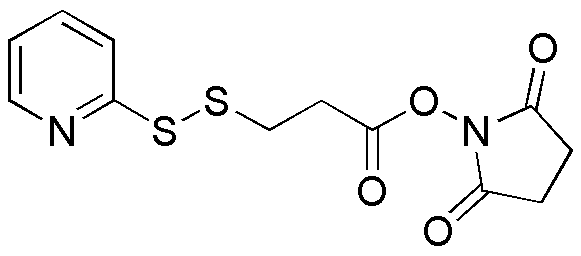3-(2-Pyridyldithio)propionic acid N-hydroxyuccinimide ester is widely utilized in research focused on:
- Bioconjugation: This compound serves as a versatile linker for attaching biomolecules, such as proteins or antibodies, to surfaces or other molecules, enhancing the development of targeted therapies in pharmaceuticals.
- Drug Delivery Systems: Its ability to form stable conjugates makes it ideal for creating drug delivery vehicles that can improve the efficacy and specificity of treatments in cancer therapy.
- Diagnostics: The compound is used in the development of diagnostic tools, such as biosensors, where it helps in the selective binding of analytes, leading to more accurate detection methods.
- Material Science: In polymer chemistry, it aids in the synthesis of functionalized polymers, which can be used in coatings and adhesives, providing enhanced properties compared to traditional materials.
- Research in Chemical Biology: It facilitates the study of protein interactions and cellular processes, enabling researchers to explore biological mechanisms with greater precision.
Información general
Propiedades
Seguridad y normativas
Aplicaciones
3-(2-Pyridyldithio)propionic acid N-hydroxyuccinimide ester is widely utilized in research focused on:
- Bioconjugation: This compound serves as a versatile linker for attaching biomolecules, such as proteins or antibodies, to surfaces or other molecules, enhancing the development of targeted therapies in pharmaceuticals.
- Drug Delivery Systems: Its ability to form stable conjugates makes it ideal for creating drug delivery vehicles that can improve the efficacy and specificity of treatments in cancer therapy.
- Diagnostics: The compound is used in the development of diagnostic tools, such as biosensors, where it helps in the selective binding of analytes, leading to more accurate detection methods.
- Material Science: In polymer chemistry, it aids in the synthesis of functionalized polymers, which can be used in coatings and adhesives, providing enhanced properties compared to traditional materials.
- Research in Chemical Biology: It facilitates the study of protein interactions and cellular processes, enabling researchers to explore biological mechanisms with greater precision.
Documentos
Hojas de datos de seguridad (HDS)
La SDS proporciona información de seguridad completa sobre la manipulación, el almacenamiento y la eliminación del producto.
Especificación del producto (PS)
La PS proporciona un desglose completo de las propiedades del producto, incluida la composición química, el estado físico, la pureza y los requisitos de almacenamiento. También detalla los rangos de calidad aceptables y las aplicaciones previstas del producto.
Certificados de análisis (COA)
Busque certificados de análisis (COA) ingresando el número de lote del producto. Los números de lote y de partida se pueden encontrar en la etiqueta de un producto después de las palabras "Lote" o "Lote".
Número de catálogo
Número de lote/lote
Certificados de origen (COO)
Este certificado de origen confirma el país en el que se fabricó el producto y también detalla los materiales y componentes utilizados en él y si se deriva de fuentes naturales, sintéticas u otras fuentes específicas. Este certificado puede ser necesario para cumplir con las normativas aduaneras, comerciales y regulatorias.
Número de catálogo
Número de lote/lote
Hojas de datos de seguridad (HDS)
La SDS proporciona información de seguridad completa sobre la manipulación, el almacenamiento y la eliminación del producto.
DownloadEspecificación del producto (PS)
La PS proporciona un desglose completo de las propiedades del producto, incluida la composición química, el estado físico, la pureza y los requisitos de almacenamiento. También detalla los rangos de calidad aceptables y las aplicaciones previstas del producto.
DownloadCertificados de análisis (COA)
Busque certificados de análisis (COA) ingresando el número de lote del producto. Los números de lote y de partida se pueden encontrar en la etiqueta de un producto después de las palabras "Lote" o "Lote".
Número de catálogo
Número de lote/lote
Certificados de origen (COO)
Este certificado de origen confirma el país en el que se fabricó el producto y también detalla los materiales y componentes utilizados en él y si se deriva de fuentes naturales, sintéticas u otras fuentes específicas. Este certificado puede ser necesario para cumplir con las normativas aduaneras, comerciales y regulatorias.

